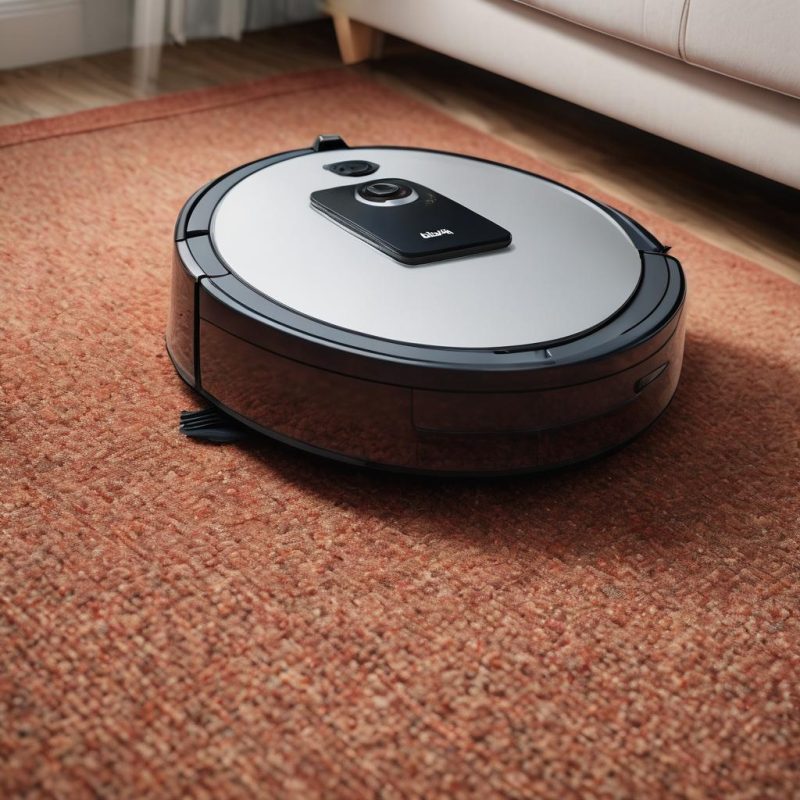Table of contents
- The Basics: How Robot Vacuums Function
- Factors Affecting Robot Vacuum Efficiency on Carpets
- Challenges Faced by Robot Vacuums on Carpets
- Advanced Features and Their Impact on Carpet Cleaning
- Maintenance for Optimal Performance on Carpets
- Are Robot Vacuums a Replacement for Traditional Vacuums on Carpets?
- Conclusion:

In the age of smart homes and automation, robot vacuums have taken center stage as one of the most sought-after household gadgets. Compact, efficient, and seemingly autonomous, these modern devices promise to relieve homeowners of the tedious chore of vacuuming. But when it comes to carpets, many are left wondering: do robot vacuums truly deliver? Can they effectively clean varying carpet textures, from low-pile office carpets to plush, high-pile rugs? Let’s embark on a detailed exploration of the efficacy of robot vacuums on carpets.
The Basics: How Robot Vacuums Function
Before diving into specifics, it’s essential to understand the basic workings of a robot vacuum. These devices typically employ a combination of brushes, rollers, and suction to pick up dirt, debris, and pet hair. Advanced models incorporate smart navigation, mapping your home to ensure comprehensive coverage, while others operate based on random patterns.
Factors Affecting Robot Vacuum Efficiency on Carpets
1. Suction Power:
Carpets, by nature, trap more dirt and dust than hard floors. A robot vacuum needs strong suction power to extract dirt from between carpet fibers effectively. Not all robot vacuums are created equal in this aspect. Higher-end models typically boast more robust suction capabilities, making them more efficient on carpets.
2. Brush Design:
The design and type of brushes a robot vacuum is equipped with play a crucial role in its carpet cleaning capabilities. Ideally, a robot vacuum should have a combination of rotating brushes to agitate carpet fibers and channel debris towards the vacuum’s suction path.
3. Height Adjustment:
Some advanced robot vacuums can detect the type of surface they are on and adjust their height accordingly. This feature ensures they maintain optimal contact with the carpet, maximizing cleaning efficiency.
4. Battery Life:
Carpets provide more resistance than hard floors. As a result, robot vacuums use up more battery life when operating on carpets. A device with a longer battery life or intelligent battery management can sustain prolonged cleaning sessions, ensuring the entire carpeted area is cleaned.
Challenges Faced by Robot Vacuums on Carpets
1. Thick Piles and Rugs:
High-pile carpets and thick rugs can pose challenges for some robot vacuums. They may become stuck or unable to move efficiently, leaving patches of carpet uncleaned.
2. Tassels and Loose Threads:
Carpets or rugs with tassels and loose threads can become entangled in the vacuum’s brushes, hindering its function and potentially causing damage.
3. Limited Dirt Detection:
While many robot vacuums possess dirt-detecting sensors, they may not always identify deeply embedded dirt within carpets, leading to less thorough cleaning.
Advantages of Using Robot Vacuums on Carpets
1. Regular Maintenance:
One of the primary benefits of robot vacuums is their ability to schedule regular cleaning sessions. Consistent cleaning can help maintain carpets, preventing dirt buildup over time.
2. Smart Navigation:
Advanced models can map out rooms, ensuring they cover every inch of the carpeted floor, often in methodical patterns.
3. Multi-surface Transition:
Many robot vacuums can transition seamlessly from hard floors to carpets, providing holistic cleaning solutions for homes with mixed flooring.
Advanced Features and Their Impact on Carpet Cleaning
As robot vacuums continue to evolve, manufacturers are integrating sophisticated features that enhance their carpet cleaning capabilities. Here’s a more in-depth look at some of these advancements:
1. Advanced Mapping and Zoning:
Beyond just mapping a home’s layout, some high-end robot vacuums now allow users to create virtual barriers or designate specific zones for cleaning. If you have a particular carpeted area that accumulates more dirt – perhaps a high-traffic zone near the main entrance – you can instruct your robot vacuum to focus more on that area.
2. Dirt Detect Technology:
This feature enables robot vacuums to recognize particularly dirty areas and spend more time cleaning them. Such technologies enhance the cleaning efficacy on carpets, ensuring that stubborn dirt doesn’t go unnoticed.
3. High-Efficiency Filters:
While the primary purpose of a vacuum is to pick up dirt, it’s equally crucial to ensure that the same dirt isn’t spewed back into the environment. Robot vacuums with HEPA filters or similar high-efficiency filters capture the fine particles and allergens from carpets, making the air cleaner and healthier.
4. Turbo Mode on Carpets:
Some robot vacuums come with an automatic mode-switching feature. When they detect a carpeted surface, they automatically switch to a ‘turbo’ or ‘max’ mode, which increases suction power, ensuring a deeper clean.
5. Edge Cleaning:
Considering that dirt tends to accumulate around edges and corners, some robot vacuums are equipped with specialized edge-cleaning modes. These modes make the vacuum focus on the room’s perimeter, ensuring the edges of your carpeted rooms aren’t neglected.
Maintenance for Optimal Performance on Carpets
No matter how advanced a robot vacuum might be, regular maintenance is essential for it to function effectively, especially on carpets. Here are some tips:
- Clean the brushes regularly. Hair, threads, and other debris can get tangled in the brushes, reducing their efficiency.
- Empty the dustbin after every cleaning cycle. A full dustbin can hamper the vacuum’s suction capability.
- Clean the sensors and filters. Dust and grime on sensors can affect the robot vacuum’s navigation and dirt detection ability.
- Check wheels for obstructions. Ensure that the wheels move freely, as carpets already offer resistance, and any additional obstruction can affect mobility.
Are Robot Vacuums a Replacement for Traditional Vacuums on Carpets?
While robot vacuums offer incredible convenience and are becoming increasingly adept at cleaning carpets, they might not yet fully replace the deep cleaning capabilities of traditional upright or canister vacuums, especially for plush, high-pile carpets. They’re excellent for maintenance cleaning, ensuring your carpets remain relatively dirt-free between those deep cleaning sessions.
Conclusion:
To answer the burning question: Yes, robot vacuums do work on carpets, but their efficiency varies based on the model, carpet type, and features they come equipped with. As technology continues to advance, it’s likely that robot vacuums will only become more adept at handling the challenges carpets present. For now, ensure you pick a model tailored to your specific needs, and enjoy the convenience of automated cleaning, even on your cozy carpets!
